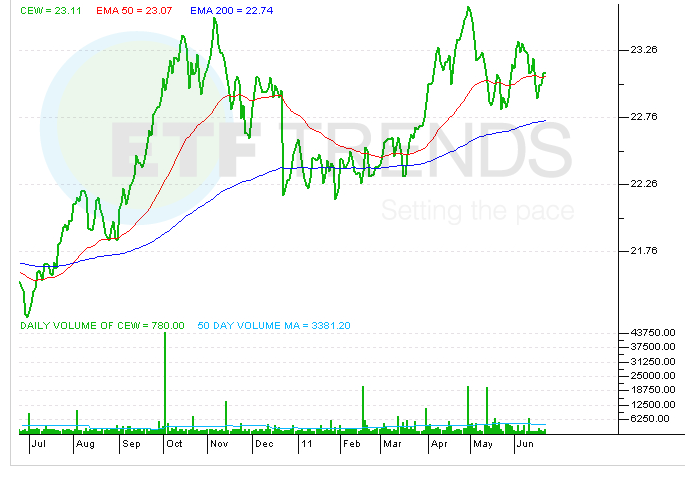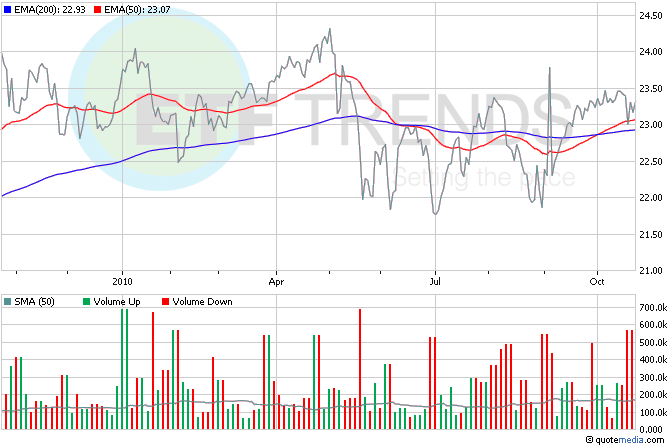Trading Currency ETFs
Post on: 21 Апрель, 2015 No Comment

When considering that one of our blog posts this week focuses on global macro trading techniques, this makes this topic very relevant to every forex trader.
What are currency ETFs and how can you trade them? Currency ETFs are exchange traded funds that deals in one or more national currencies. Thus a currency exchange traded fund provides an opportunity for traders and investors to focus their trading attention to a particular national economy and the currency of that economy. For instance, a trader may want to focus on the Euro solely based on the happenings out of the troubled Eurozone countries, without having to contend with the intervening mechanics and dynamics of the pairing of the Euro with other currencies. It therefore makes sense in such circumstances to focus strictly on trading the Euro as a single entity by using a currency ETF that tracks the performance of the Euro exclusively.
Similarly, a trader may want to trade the Japanese Yen exclusively based on the effect of the tsunami and the resultant Fukushima Daichi nuclear plant fallout, or perhaps the effect of Abenomics on the JPY. Without wanting to start figuring which Yen cross to trade and how to trade it, the trader may opt to trade a currency ETF which tracks the performance of the JPY in reaction to these events.
Simply put, currency ETFs allow traders to trade a single currency and takes out the pairing dynamics that have to be contended with in the conventional spot forex market. Currency ETFs are a safer way to play the currency markets, especially for those who do not have the balls to take on the day to day fluctuations of the market.
How Currency ETFs Work
Currency ETFs can track a currency in a direct relationship, in which case the value of the ETF will increase as the currencys value increases. A currency ETF can also track a currencys performance in an inverse fashion, gaining value as the value of the currency falls.
In order to trade currency ETFs, a trader would have to open a brokerage account and fund it. Currency ETFs are traded just the way any regular stock is traded. A currency ETF can be traded in two directions; a trader can go long or go short on a currency ETF just like any other currency trade. They are also traded on margin and leverage, and it is possible to use market orders as well as limit/stop orders to initiate trade positions on the currency ETFs.
With currency ETFs, a trader can gain investment exposure to even currencies that are not regularly listed on the forex brokerage platforms.
Currency ETFs work by replicating the day-to-day movements of a particular currency or basket of currencies in the forex market in two ways:
a) The fund (i.e. the currency ETF) can hold currency cash deposits in the currency whose performance is being tracked.
b) The currency ETF may make use of futures contracts on the underlying currency or currencies.
Whichever way that the currency ETF operates, the currency ETF is structured to provide a very high correlation in terms of returns, to the actual movements of the single currency or the currency basket over a period of time.
What Currency ETFs to Trade
There are so many currency ETFs out there to choose from that the trader may even experience some degree of confusion when making a selection.
As a trader, it is possible to purchase ETFs that track a single currency. This strategy is mostly used by traders when they want to trade a country-specific event in the forex market. Let us assume that the trader wants to trade the Confederatio Helvetica Franc (Swiss Franc) as an ETF. An example of a currency ETF tracking the Swiss Franc is the CurrencyShares Swiss Franc Trust (NYSE:FXF). A trader who believes that the value of the Swiss franc will rise against the U.S. dollar, will have to go long on this ETF since it is a currency ETF that tracks the Swiss Francs performance on a direct basis. If the trader believes that the Swiss Francs value will drop based on rumours concerning the upward adjustment of the minimum exchange rate peg, he may then go short on the ETF.
How about if the trader sees an opportunity in the Japanese Yen and wants to maximize profit from the inverse movement of a currency ETF which tracks the movement of the JPY against the US Dollar? Then the trader can decide to purchase the ProShares UltraShort Yen ETF (YCS), which tracks twice the inverse daily movement of the Japanese Yen relative to the greenback. This currency ETF works in reverse. As the value of the Yen increases against the US Dollar, the value of the YCS currency ETF decreases. So assuming a trader wanted to trade the increase of the USDJPY currency pair from September 2012 to May 2013, then the trader would have to go long on the ProShares UltraShort Yen ETF (YCS), aiming to get twice the return since this ETF is leveraged.
Take a look at the performance of the YCS and the USDJPY:
The USDJPY daily chart from Aug 2012 to date
The ProShares Ultrashort Yen ETF from Aug 2012 to date
The correlation is there for all to see.
The trader can also decide to purchase currency ETFs that track a basket of different currencies. For example, a strategy would be to take a position in such an ETF if a currency is expected to gain value or weaken broadly over a range of currencies. Since many ETFs track the performance of a currency or group of currencies against the US Dollar, it would make sense to purchase a currency ETF basket so that if the currencies in the basket gain broadly against the USD or the USD weakens broadly against these currencies, the trader can turn a good profit. An example of such multiple currency ETFs would be the PowerShares DB U.S. Dollar Bullish (NYSE:UUP) and Bearish (NYSE:UDN) ETFs, which tracks the following currencies:
a) Euro
b) Japanese yen
c) British pound
d) Canadian dollar
e) Swedish krona
f) Swiss franc.
So if a news item comes out of the US which causes the U.S. dollar to strengthen broadly, the Powershares DB U.S. Dollar Bullish ETF is a good ETF to buy to track this performance.
Currency ETF Trading in the Context of Global Macro Economics
For you to fully understand this next section, please read the blog post on Global Macro Trading Strategies. In that blog post, we dealt with what is responsible for long term currency trends and how global outlook forecasts shape the risk sentiment of traders and subsequently, their trade positions.
If you will be trading a currency ETF, it is very important to know what the global growth outlook will be for each contributory zone: the United States (USD, CAD), China (AUD, NZD), Europe (EUR, GBP) and the rest of the world, pushed on by the emerging market economies of Brazil, India, Russia and South Africa (BRICS without the China component, which is handled separately). These regions contribute a certain percentage to the worlds GDP, and therefore growth forecasts will ultimately shape the sentiment traders have for the currencies listed.
If you will be choosing a currency ETF, you must take these into cognisance. We also talked about the key news items to watch out for in 2014.
As a currency ETF trader, you must compile a list of ETFs that track the currencies placed in parentheses, and decide which of the ETFs you should trade based on outlook.
When trading currency ETFs, beware of the risk factors that could also come to play, which could cause sudden changes in risk sentiment and market perception towards certain currencies. Some of these risks border on the following:

a) Sovereign debt (Eurozone)
b) Trade deficits (United States)
c) Interest rate changes (virtually all major currencies)
d) Central banks interventions (Switzerland and Japan)
e) Commodity price changes (Australia and Canada)
f) Regime changes
All these factors must be taken into consideration when trading currency ETFs, especially if the buy and hold long term strategies are used. It will take some degree of experience in the ETF market to fully grasp how to trade these scenarios.
Currency ETF Trade Example
Here is a currency ETF trade example to show you how to pick a currency ETF to trade a particular market situation.
Let us assume that the Fed Reserve failed to carry out the expected QE Tapering that the markets had so furiously anticipated. Obviously since it was a surprise news announcement with a downside outcome, such news would not be good for the US Dollar in the short term which weakened across board following release of the news item. What would be the best way to trade this?
Solution to Quiz
The best way to maximize profits from this is to trade a USD bearish ETF such as the PowerShares DB U.S. Dollar Bearish (NYSE:UDN). On release of the news, the trader would head over to his brokers platform, select the number of units of the UDN to purchase, and go short at a price of 27.02, with a stop placed above the nearest resistance and profit target set at the nearest short term support. This trade is a short term trade because the US Dollar is not expected to fall sharply.
We can see from the trade chart that the PowerShares DB U.S. Dollar Bearish (NYSE:UDN) dropped in value in correlation with the broad weakness of the US Dollar against major currencies in reaction to this news item:
UDNs Performance in Reaction to Fed Reserve Move to Leave QE Program Intact. Source: Bloomberg.com
This is a way to trade currency ETFs in the market. Traders can practice using the various ETFs listed in the market. A full list of the available currency ETFs can be obtained by a scan of the search engines.
Attention!
The author’s views are entirely his or her own.














